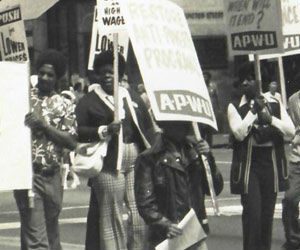October 31, 2012
Minnesota Timber Workers Triumph Over Lumber Barons
In 1937, at the height of the Great Depression, Minnesota’s timber workers triumphed over daunting odds to launch two successful strikes, achieve union recognition, and negotiate unprecedented improvements in wages and living conditions. Their success arose from a collective resolve to gain control over their lives.
In the 1930s, a decline in the demand for lumber led to worsening conditions for loggers. At the same time, labor agitation swept the nation. A vast strike wave proved to woodworkers that economic injustice could be corrected with mass working-class action.
Skilled craft unions of the American Federation of Labor (AFL) had little interest in organizing unskilled immigrants like the Finnish and eastern European timber workforce. Nevertheless, the AFL granted the workers a charter to form Local 2776 of the Timber Workers Union, a subsidiary of the United Brotherhood of Carpenters and Joiners.
Launching Their First Strike
In the fall of 1936, union activists who hoped to strengthen Local 2776 discussed grievances with workers and developed a core of support in northern Minnesota’s larger camps operated by General Logging and International Lumber. In December, they presented the companies with their demands.
Still loosely organized, the union’s demands were met with ridicule by management.
On Jan. 4, 1937, Local 2776 resolved to strike. Hundreds of timber workers walked off the job each day, as word of the strike spread from camp to camp. By the end of the first week, the strikers’ numbers swelled to more than 4,000. Heartened union representatives declared the strike statewide, and, much to the surprise of lumber-company officials, logging ceased throughout northern Minnesota.
The timber workers found an ally in Minnesota Gov. Elmer A. Benson of the Farmer-Labor party, whose strong stand on behalf of the timber workers prevented local officials from breaking the strike’s momentum.
The union also relied on ethnic networks that provided material and moral support. Finnish social halls served as union meeting places for striking workers. Working-class newspapers such as Hibbing’s St. Louis County Independent and the Finnish paper Työmies spread information to workers throughout lumber towns.
Facing public support for the strikers, a governor determined to protect workers’ rights, and pressure to remove lumber before the first snow-melt halted operations for the season, timber bosses decided to negotiate.
On Jan. 21, the two sides met, and within two days reached an agreement granting timber workers most of their demands. The contract established an eight-hour day, granted the union recognition, increased piece rates, and improved camp sanitation. Workers accepted wages of $70 per month, and a commitment that the cost of boarding would not exceed $1 per day.
Buoyed by the successful strike, workers elected stewards in every camp, and the union hired full-time agents to maintain communication between camps. The union also launched its own newspaper, Midwest Labor.
A Public Battle
The contract was set to expire just nine months later, when the next cutting season would begin, and workers believed they needed regional support to ensure that they would obtain a new agreement. To accomplish this goal, they established union locals in Park Falls, WI, and Ironwood, MI.
The lumber companies also organized, forming the Minnesota Timber Producers Association (MTPA), which represented 85 percent of the state’s lumber production.

In August, the MTPA and the timber union began negotiations for a new contract, and after seven weeks, on Oct. 16, the lumber companies offered a proposal that withdrew many gains won in the first strike.
In response, union representatives traveled from camp to camp to take a strike vote. The tally was nearly unanimous in favor, and within a few days 4,000 Minnesota woods workers again walked off the job.
Timber workers organized public meetings, met with farmers and members of other unions, distributed copies of Midwest Labor, and explained their cause on a Duluth radio station.
Lumber companies launched a campaign to convince the public that their proposal was reasonable. Fred Bessette, secretary of the MTPA, told the Duluth News Tribune that workers were offered “a general increase of 33 percent over wages a year ago.” He failed to mention that the increase wouldn’t apply to the majority of workers, who were paid by piece rate.
The MTPA also attempted to split the farmer-labor alliance that had strengthened the workers’ cause. Farmers, who had been drawn into purchasing deforested land from lumber companies only to discover that the soil produced meager crops, identified with the timber workers’ struggle.
The MTPA tried to convince the farmers that the union threatened their livelihood. Leading the timber industry’s anti-union efforts was Frank T. Ronkainen, who presented himself as a humble farmer, but was actually a contractor for International Lumber.
Disgusted with Ronkainen’s hostility, one timber worker responded in Midwest Labor:
“He calls us a bunch of floaters, people who don’t own property and pay taxes. Funny, isn’t it? First you rob a man and then you swear at him because he hasn’t any money…following the woods from camp to camp…wherever there’s work…sleeping in filthy bunks lousy with bedbugs …a rotten, stinking kind of living…going to town with nothing to do but get crazy drunk…and back to the woods…Never make enough money to marry and settle down and raise a family. Men weren’t meant to live like that… it ain’t living.”
The timber producers’ attempt to divide farmers and laborers backfired. Farmers’ groups and ethnic associations of northern Minnesota sent dozens of letters to Gov. Benson expressing their solidarity with the timber workers.
By early November, Midwest Labor reported, pickets had brought lumber hauling to a standstill, and on Nov. 17, a tense situation unfolded 19 miles west of Duluth. Seventeen trucks loaded with lumber spent the day in a standoff with a picket line organized to block shipments to mills in Cloquet. The trucks retreated when state police refused to escort them through the line.
The stand-off, however, resumed the next day. Amid demands for a declaration of martial law by Carlton County officials, Gov. Benson assured workers that the highway patrol would not break their picket line. The pickets stood their ground, and on the morning of Nov. 21, word reached the strikers that an agreement had been reached. The final contract, a victory for the union, was ratified in the next few days.
The union won a long-sought clause granting a 10-day guarantee for piece workers, and an 18 percent increase in piece rates. Regular workers’ settled for a raise of $75 a month. The eight-hour day and 48-hour workweek were retained, and workers would no longer have to pay their own employment fees. The agreement, scheduled to remain in effect until Sept. 1, 1938, also forbade discrimination against strike participants.
Minnesota’s timber workers accomplished what seemed impossible: They organized a poor, unskilled, and widely scattered workforce in an industry that for decades had dominated its workers. The strong commitment to collective action, support from the people of northern Minnesota, and Gov. Benson’s unwavering support proved essential to their success.



